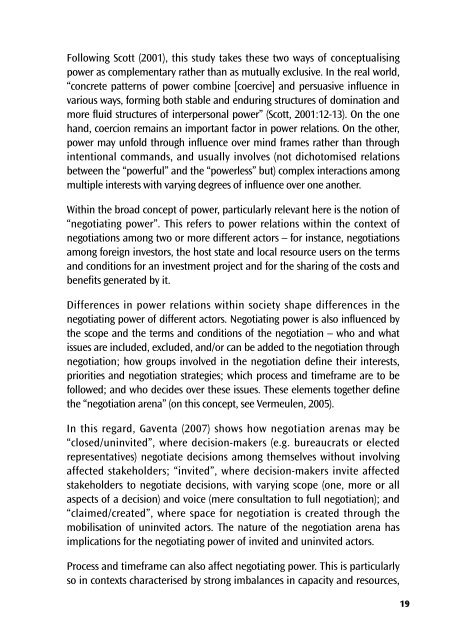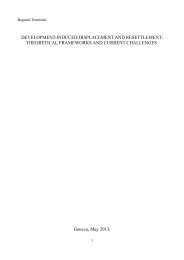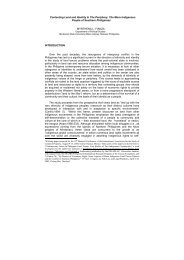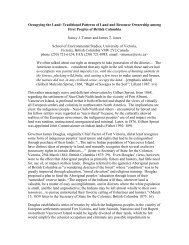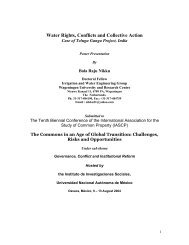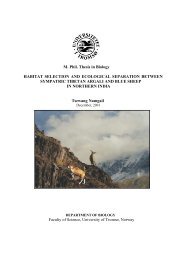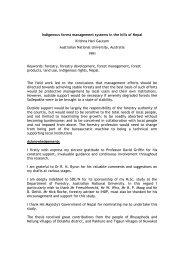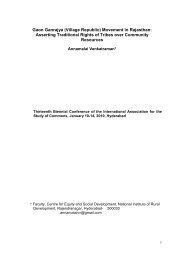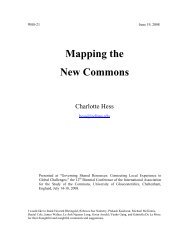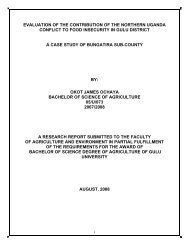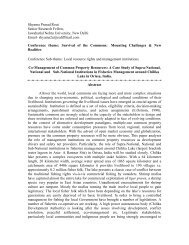Legal empowerment for local resource control
Legal empowerment for local resource control
Legal empowerment for local resource control
You also want an ePaper? Increase the reach of your titles
YUMPU automatically turns print PDFs into web optimized ePapers that Google loves.
Following Scott (2001), this study takes these two ways of conceptualising<br />
power as complementary rather than as mutually exclusive. In the real world,<br />
“concrete patterns of power combine [coercive] and persuasive influence in<br />
various ways, <strong>for</strong>ming both stable and enduring structures of domination and<br />
more fluid structures of interpersonal power” (Scott, 2001:12-13). On the one<br />
hand, coercion remains an important factor in power relations. On the other,<br />
power may unfold through influence over mind frames rather than through<br />
intentional commands, and usually involves (not dichotomised relations<br />
between the “powerful” and the “powerless” but) complex interactions among<br />
multiple interests with varying degrees of influence over one another.<br />
Within the broad concept of power, particularly relevant here is the notion of<br />
“negotiating power”. This refers to power relations within the context of<br />
negotiations among two or more different actors – <strong>for</strong> instance, negotiations<br />
among <strong>for</strong>eign investors, the host state and <strong>local</strong> <strong>resource</strong> users on the terms<br />
and conditions <strong>for</strong> an investment project and <strong>for</strong> the sharing of the costs and<br />
benefits generated by it.<br />
Differences in power relations within society shape differences in the<br />
negotiating power of different actors. Negotiating power is also influenced by<br />
the scope and the terms and conditions of the negotiation – who and what<br />
issues are included, excluded, and/or can be added to the negotiation through<br />
negotiation; how groups involved in the negotiation define their interests,<br />
priorities and negotiation strategies; which process and timeframe are to be<br />
followed; and who decides over these issues. These elements together define<br />
the “negotiation arena” (on this concept, see Vermeulen, 2005).<br />
In this regard, Gaventa (2007) shows how negotiation arenas may be<br />
“closed/uninvited”, where decision-makers (e.g. bureaucrats or elected<br />
representatives) negotiate decisions among themselves without involving<br />
affected stakeholders; “invited”, where decision-makers invite affected<br />
stakeholders to negotiate decisions, with varying scope (one, more or all<br />
aspects of a decision) and voice (mere consultation to full negotiation); and<br />
“claimed/created”, where space <strong>for</strong> negotiation is created through the<br />
mobilisation of uninvited actors. The nature of the negotiation arena has<br />
implications <strong>for</strong> the negotiating power of invited and uninvited actors.<br />
Process and timeframe can also affect negotiating power. This is particularly<br />
so in contexts characterised by strong imbalances in capacity and <strong>resource</strong>s,<br />
19


